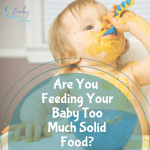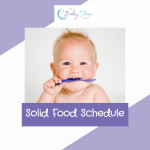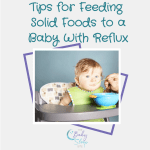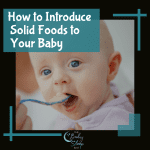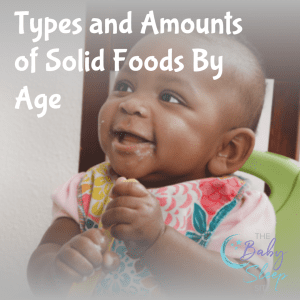
When it comes to starting your baby on solids, the list of “dos” and “don’ts” seems long, doesn’t it? Enter a simple question like, “How much should I feed my baby at each meal?” or “When should I start feeding my baby dairy?” into a search engine, and you’ll find pages and pages of answers. (Many of which contradict each other!) We know that when it comes to baby schedules, parents like to have the basics presented to them in a clear, easy-to-understand way. We’ve attempted to do just that in this article. Below, you’ll find two simple charts. The first chart outlines the types of solid foods you can feed your baby, by age. Second, you’ll find information regarding amounts and serving sizes, again, organized by age. Use both as a guide as you shop for and prepare your baby’s foods.
Remember, these charts are a general guide — they’re not set in stone! If your baby eats more servings of vegetables in a day than we’ve recommended here, good for him! We’ve simply grouped the foods based on their digestibility, texture, and allergy risk. What’s more, the serving sizes we recommend are general ranges, but all babies are unique.
You’ll also notice that this chart shows solid food beginning between 4-6 months. Based on the most recent health information, we recommend waiting until closer to 6+ months to start solids. In certain cases, your baby’s doctor may want you to start solids earlier than 6 months, so we include that here too.
As you look over the recommended amounts of solid food, keep one thing in mind: you should always prioritize your baby’s breastmilk or formula intake over your baby’s solid food intake. In other words, if your baby isn’t drinking the recommended amounts of breastmilk or formula, but is eating plenty of solid food, be sure to decrease their solid food intake and really focus on making sure they’re drinking the recommended amounts of breastmilk or formula.
Finally, keep in mind that the information offered here should never replace the advice or guidance of your baby’s doctor.
TYPES OF SOLID FOODS BY AGE
| Age | Grains | Fruits | Vegetables | Meat and Dairy | Feeding Tip |
|---|---|---|---|---|---|
| Birth-4 Months | None | None | None | None | At this age, breastmilk or formula is all a baby needs to be properly nourished. |
| 4-6 Months | Baby cereal (traditionally a baby’s very first food) | Apple, Avocado, Banana, Pear | Green Beans, Sweet Potato, Squash | None | Not sure if your baby’s ready for solids? Review the tips for when to start. |
| 7-8 Months | Same as above. | Same as above, plus cherries, mango, papaya, nectarines and peaches, and plums. | Same as above, plus carrots, cauliflower, peas, potatoes, pumpkin, and zucchini. | Poultry (chicken and turkey), beans, and legumes. Doctors used to recommend waiting to offer egg whites until after 12 months; that recommendation has changed. Now, egg yolks and whites can be introduced around 8 months. | In the beginning, it’s best to offer baby single-ingredient meals. Around 8 months, however, you can start mixing foods for more interesting tastes. |
| 9-10 Months | Same as above, plus quinoa, wheat, pasta, crackers, bread, bulgar, kasha, and millet. | As above, plus blueberries, coconut, figs, grapes (mashed), kiwi, and melon. | Same as above, plus asparagus, beans, beets, broccoli, cucumber, eggplant, mushrooms, onion, peppers, and spinach. | Same as above, including yogurt, cheese (including cottage cheese and cream cheese), beef, pork, tofu. | Begin offering your baby tiny bits of food; you can feed these to her on a spoon or spread them on a tray and encourage her to feed herself. |
| 11-12 Months | Same as above. | As above, plus tomatoes, citrus fruits, and strawberries. | Same as above, plus corn. | Same as above, plus fish. Whole milk, shellfish, nuts, and nut butters can be introduced any time after 12 months. | By this point, your baby should be feeding himself more and more. Whenever possible, offer your baby finger food at meals. |
AMOUNTS OF SOLID FOODS BY AGE (Per Day)
| Age | Liquid(per day) | Grains | Fruit | Vegetables | Meat and Dairy |
|---|---|---|---|---|---|
| Birth-4 months | 25-35 oz of breastmilk (~6 breastfeeding sessions) or 20-30 oz. formula (or combination). No water or juice. | None | None | None | None |
| 4-6 months (1-2 solid feedings per day) | 25-35 oz of breastmilk (~5-8 breastfeeding sessions) or 20-30 oz. formula (or combination). No water or juice. | 1-2 tablespoons dry infant cereal, mixed with breastmilk or formula | 1-2 tablespoons pureed fruit | 1-2 tablespoons pureed vegetables | None |
| 7-8 months (2-3 solid feedings per day) | 25-35 oz of breastmilk (~5 breastfeeding sessions) or 20-30 oz. formula (or combination). 2-3 oz. of water.** | 1-6 tablespoons dry infant cereal, mixed with breastmilk or formula | 1-6 tablespoons pureed/mashed fruit | 1-6 tablespoons pureed/mashed vegetables | Meat: 1-2 tablespoons pureed/mashed protein (offer at 8 months) Dairy: 1/4-1/2 cup yogurt or cottage cheese; 1 oz. shredded cheese |
| 9-10 months (3 solid feedings per day) | 25-35 oz of breastmilk (~4-5 breastfeeding sessions) or 20-30 oz. formula (or combination). 4-6 oz. of water.** | 2-4 tablespoons dry infant cereal, mixed with breastmilk or formula. 1-2 servings other grains* |
4-8 tablespoons mashed/chopped fruit | 4-12 tablespoons mashed/chopped vegetables | Meat: 2-6 tablespoons mashed/chopped protein Dairy: Same as 7-8 month recommendations. |
| 11-12 months (3 solid feedings per day) | 25-35 oz of breastmilk (~3-4 breastfeeding sessions) or 20-30 oz. formula (or combination). 6-8 oz. of water.** | Same as above, except increase “other grains” to 2 servings | 6-8 tablespoons mashed/chopped fruit, or 1/2 cup diced | 6-12 tablespoons mashed/chopped vegetables, or 1/2 – 3/4 cup diced | Meat: 2-6 tablespoons mashed/chopped protein, or 1/4 cup diced Dairy: Same as 7-8 month recommendations. |
*1 serving of “other grains” = 1/2 slice of bread, 2 crackers, 1/2 cup Cheerios, or 1/2 cup whole wheat pasta
**You can offer small amounts of juice at this age, too, but based on pediatric dental recommendations, we don’t advise offering much juice at all (if any). We also advise that parents offer breastmilk or formula first. Only offer juice or water if your baby is getting the breastmilk and/or formula he needs each day.
Everything You Need To Know About Starting Solids – All In One e-Book!
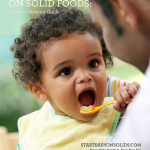 What if you could find everything you needed to know about starting your baby on solid foods – when it’s best to start solids, how to introduce solids, complications, food allergies, etc. – in one easy-reference guide? Now you can! Your Baby’s Start To Solid Foods: A Comprehensive Guide will walk you through every step of starting solids. Plus, your e-Book package includes several bonus materials, which are designed to maximize your success in starting solids. You’ll get a thorough guide to treating constipation, a dietitian’s advice on how to avoid 5 common solid-foods mistakes, and a weekly meal plan for your baby’s first year. Grab your e-Book today, and ensure your baby has the healthiest possible start to solid foods!
What if you could find everything you needed to know about starting your baby on solid foods – when it’s best to start solids, how to introduce solids, complications, food allergies, etc. – in one easy-reference guide? Now you can! Your Baby’s Start To Solid Foods: A Comprehensive Guide will walk you through every step of starting solids. Plus, your e-Book package includes several bonus materials, which are designed to maximize your success in starting solids. You’ll get a thorough guide to treating constipation, a dietitian’s advice on how to avoid 5 common solid-foods mistakes, and a weekly meal plan for your baby’s first year. Grab your e-Book today, and ensure your baby has the healthiest possible start to solid foods!

